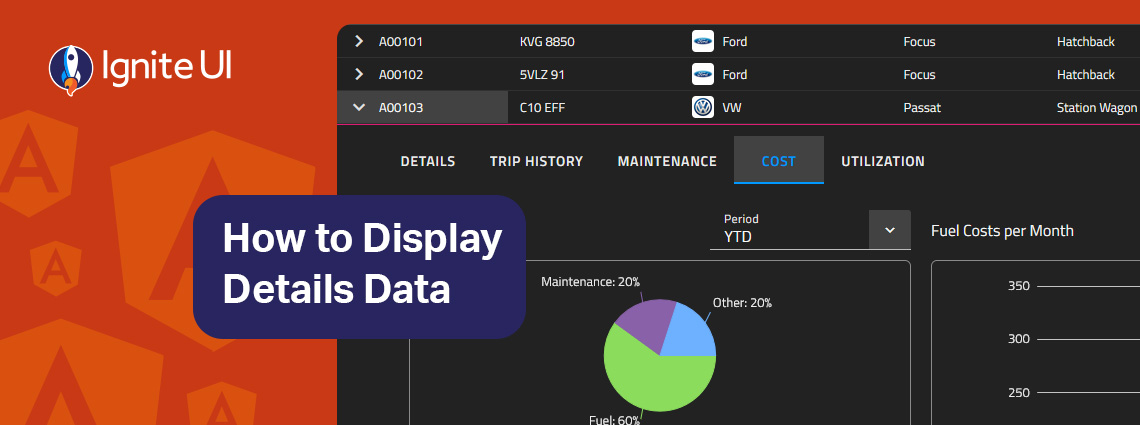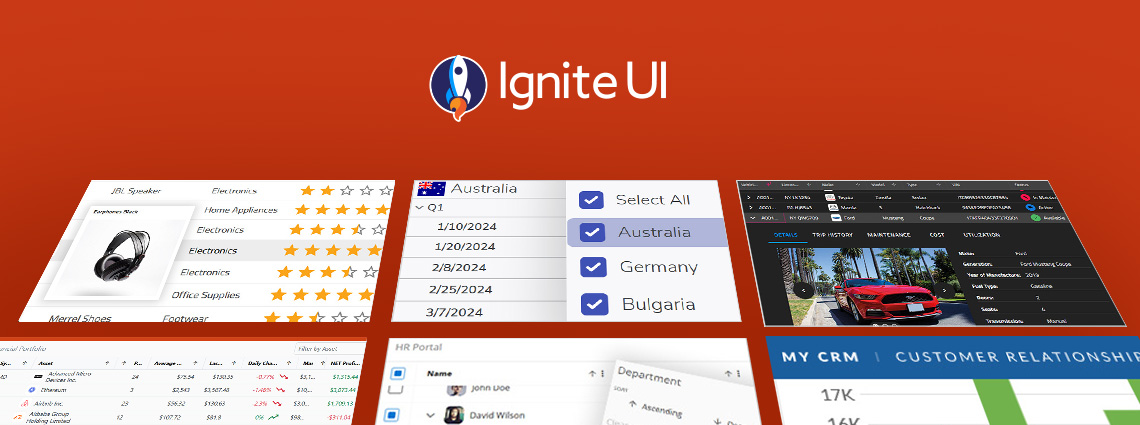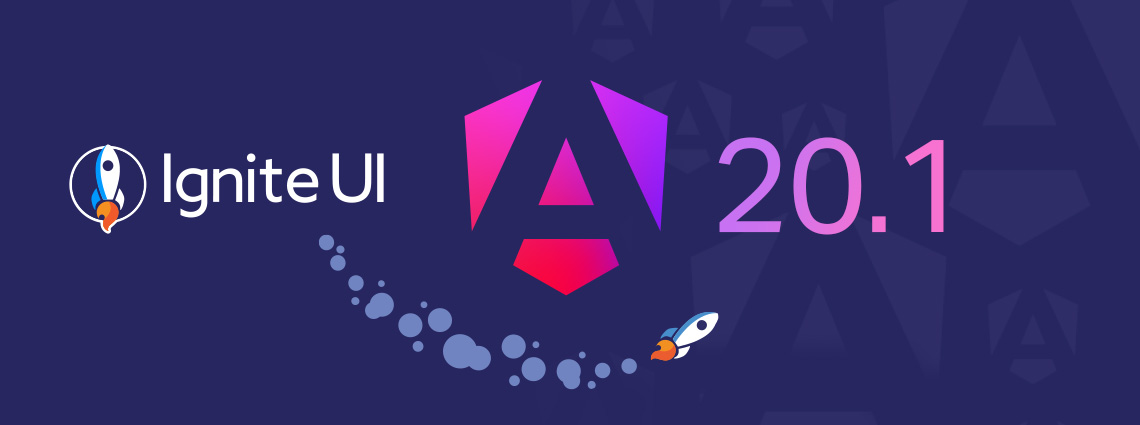
Building Your First Angular PWA with Ignite UI for Angular
An Angular Progressive Web App is a web application enhanced with native-like features such as offline access, background synchronization, etc. And this blog post shows you how to build one.
Why spend weeks building separate native apps when you can deliver the same speed and experience in a fraction of the time? Modern dev teams don’t have the luxury of slow builds anymore. An Angular PWA changes the game by combining the reach of the web with the power and performance of native apps. These apps are fast, installable, and work offline, giving users an app-like experience directly from their browser. When paired with Angular, you can deliver a reliable, responsive experience across devices using a single codebase.
While Angular simplifies PWA creation with built-in support for Service Workers and caching, Ignite UI for Angular takes things further, offering a complete suite of pre-built, high-performance UI components designed for speed, accessibility, and visual consistency.
In this article, then, you’ll learn how to build your first Angular Progressive Web App step by step, using Ignite UI to accelerate development and deliver an outstanding user experience.
What Is a PWA in Angular?
An Angular Progressive Web App is a web application enhanced with native-like features such as offline access, background synchronization, caching, and installability. In Angular, PWAs are powered by Service Workers, which store and serve application files locally to ensure instant loading, even without a network connection.
When you add PWA support to an Angular project, the framework automatically configures the necessary files and registration logic for you. You can do this with a single CLI command:
ng add @angular/pwa
This command automatically:
- Adds a manifest.webmanifest file that defines your app name, icons, and theme colors.
- Registers a Service Worker.
- Configures caching rules in ngsw-config.json.
- Makes your app installable on both desktop and mobile devices.
Behind the scenes, Angular’s Service Worker caches static assets like JavaScript bundles, images, and CSS files. It can also cache API responses based on custom rules you define in ngsw-config.json. This improves perceived performance, allowing your app to open instantly on repeat visits and function reliably when offline.
Angular’s built-in tooling simplifies this process dramatically. You don’t have to manually handle caching logic or manifest setup. Everything is scaffolded and optimized automatically, leaving you free to focus on your app’s functionality and design.
Setting Up Your Angular PWA
Step 1: Create a New Angular Project
ng new angular-pwa-demo cd angular-pwa-demo
Optionally, you can use our low-code App Builder™ to jump-start your project and generate Angular code instantly. In that case, skip step 3 and just run npm install once you download the app.
Step 2: Add PWA Support
ng add @angular/pwa
Step 3: Install Ignite UI for Angular
ng add igniteui-angular
You can skip this step if you created your project using App Builder.
Step 4: Start
When you’re ready to test your app as an actual PWA (with caching and offline support):
ng build --configuration production npm install -g angular-http-server angular-http-server --path dist/angular-pwa-demo/browser -p 3200
Ignite UI offers over 100 UI components, from data grids and charts to navigation and input controls — ready for enterprise-grade applications. You can follow this getting started guide to run it properly if needed.
Your app is now installable and PWA-ready.
Building the UI with Ignite UI for Angular
Once you’ve installed Ignite UI for Angular, you can start building your PWA’s user interface by importing the components you need and using them directly in your templates.
Example:

You can use your components in the html like this:

Add a Navbar:
<igx-navbar title="PWA Dashboard"></igx-navbar>
Display Data Using the Grid:
<igx-grid [data]="northwindEmployees" primaryKey="employeeID" [allowFiltering]="true" filterMode="excelStyleFilter" class="grid">
<igx-column field="employeeID" dataType="number" header="employeeID" [filterable]="true" [sortable]="true" [selectable]="false"></igx-column>
<igx-column field="lastName" dataType="string" header="lastName" [filterable]="true" [sortable]="true" [selectable]="false"></igx-column>
<igx-column field="firstName" dataType="string" header="firstName" [filterable]="true" [sortable]="true" [selectable]="false"></igx-column>
</igx-grid>
Add a Chart:
<igx-pie-chart [dataSource]="northwindEmployees" labelMemberPath="title" valueMemberPath="employeeID" class="pie-chart"></igx-pie-chart>
These examples are simplified but demonstrate how easy it is to build responsive, accessible UIs with Ignite UI for Angular. The components are optimized for mobile, touch, and performance — key traits of a modern Angular PWA. Do not forget css.
Optimizing Performance & Offline Experience
Performance and reliability are key to delivering a high-quality Progressive Web App (PWA). You can read our guide on how to Improve Performance of Angular App and follow the best practices outlined there to ensure your application loads fast and works seamlessly offline.
1. Audit Your Current Performance
Use Chrome DevTools → Lighthouse to measure performance and PWA readiness.
Aim for scores above 90 in both Performance and PWA categories.

2. Implement Lazy Loading
Reduce your app’s initial bundle size by loading modules and routes only when needed.
Example:

3. Optimize Caching & Offline Strategy
Configure Angular’s Service Worker (ngsw-config.json) to prefetch essential assets and cache API data for offline use. Use Chrome DevTools → Network → Offline to verify that your app loads successfully without a network connection.

4. Leverage Ignite UI’s Optimization
Ignite UI components, such as the best Angular Grid on the market, use virtualization and lightweight rendering to efficiently display large datasets. This approach minimizes memory usage, reduces frame drops, and delivers smoother scrolling, which is critical for PWAs on mobile devices.
Here’s an Angular PWA example project: Angular PWA Dashboard
It’s important to note that a simple Angular Progressive Web App example using Ignite UI might include:
- A responsive navbar for navigation.
- An IgxGrid for displaying data.
- An IgxCategoryChart for visualizing trends.
- A registered Service Worker for offline support.
You’ll get an installable, offline-ready Angular PWA that can be deployed once you run it in production:
If you see that, your service worker is registered and controlling the page.
Wrap Up…
Building a Progressive Web App with Angular doesn’t have to be complex. Angular handles caching, offline mode, and manifest configuration, while Ignite UI for Angular provides a robust set of modern UI components that enhance usability, maintain visual consistency, and maximize performance.
By combining these two technologies, you can create installable, high-performance web apps that rival native mobile experiences in speed and responsiveness.
PWAs built with Angular and Ignite UI reduce time-to-market for development teams and offer superior performance across all devices. Whether you’re building an analytics dashboard, an internal business tool, or a customer-facing application, this combination delivers consistent quality, maintainability, and a seamless user experience.
Start building your first Angular PWA today and bring app-like performance to the web with Ignite UI for Angular.

